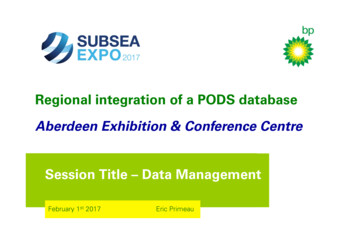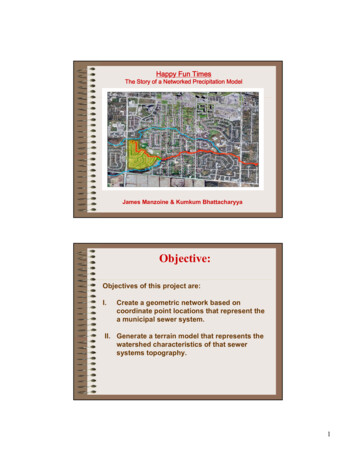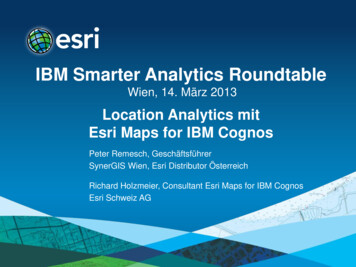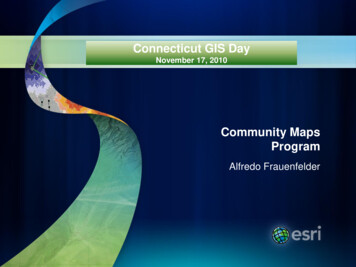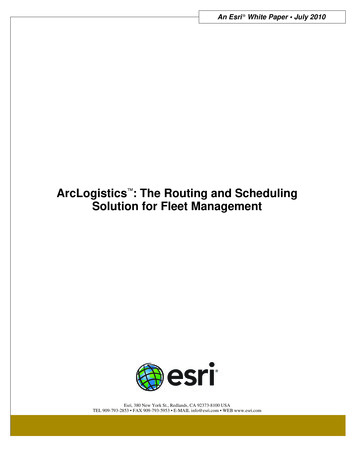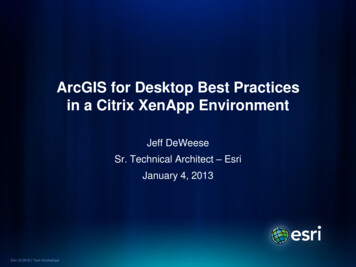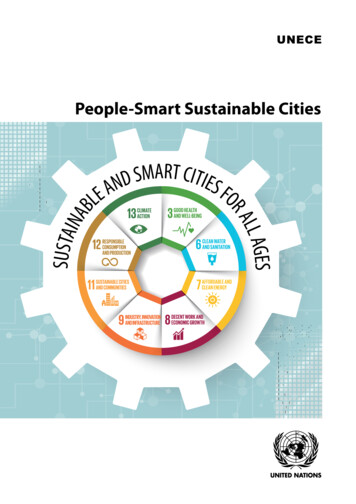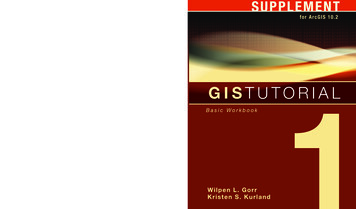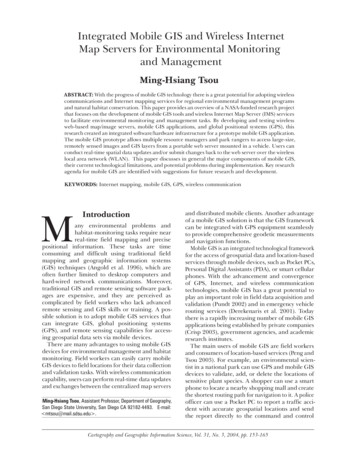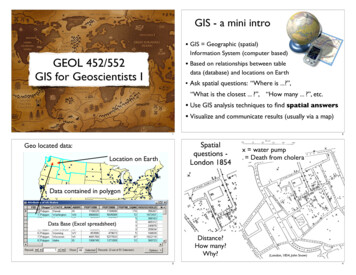
Transcription
FOR PRIVATE CIRCULATION, NOT FOR SALEJanuary - March, 2015 Vol. 9 Issue 1GIS for Smart CitiesCover StoryGIS for Smart CitiesGlobal ViewGeospatial Technology and theFuture of the CityCase StudySingapore’s Sustainable Development ofJurong Lake DistrictBig t
Build Smart Citieswith Esri CityEngineCreate High-Quality 3D ContentDesign urban layouts in 3D for analysis and reviewModel 3D environments for entertainment and simulationQuickly create 3D models using real-world 2D GIS dataesri.com/cityengine
PRESIDENT’S DESKThe pace of urbanization is speeding up in India with an expectation of betterfacilities and living conditions. Last year Ministry of Urban Development (MoUD)initiated the much laudable national programme for urban India – ‘Smart Cities’,to match the pace of urbanization and further drive economic development. Thefocus is on building green field cities as well rebuilding or retrofitting existingcities to be smart, future ready and sustainable. The government is already in theprocess of defining detailed guidelines and approach for the selection of cities andexecution plans from operational perspective.Weather it is a green-field smart city or an upgrade of an existing city into a smartcity, we are all aware of the relevance of Geographic Information System (GIS)and its role right from the planning stage. Location is a common denominatorin every aspect of a smart city and hence a location platform i.e. a GIS basedtechnology platform has to form its backbone from the very beginning includingfor ICT planning and deployment. A centralized information system based on GISprovides an IT framework which integrates every aspect of a smart city – startingfrom conceptualization, planning and development to maintenance.Smart planning, transparency in governance, smart energy, smart infrastructure,smart buildings, smart security, public safety, smart traffic management, smart wastedisposal and smart service delivery mechanisms are some of the key componentsof any smart city. GIS integrates all aspects of city planning and managementproviding a common operating picture to all. As smart city involves multiplestakeholders, the integration, coordination and synergistic functioning of differentparticipants of the smart city ecosystem is the key for the project to be successful.In this issue, we explore the role of GIS in the smart city ecosystem. We presentto you a collection of articles, global references and case studies which we thinkwould be useful for everyone including city administrators, planners, utilities andIT solution providers in exploring the new approach of GIS based urban planningthrough Geodesign.Agendra Kumaresriindia.comVol. 9ArcIndia News3
Content03PRESIDENT’S DESK05NEWS-Rajendra S Pawar, Chairman, NIIT Group gets lifetime achievement award forpromoting GIS in India0913-Esri India launches ‘Geodesign’ tool for planning smart cities-Esri launches ArcGIS Open Data website-Why Singapore is moving to 3D maps for urban planning-ArcGIS 10.3 now certified OGC compliant-ARC Advisory Group report highlights Esri as leader in global GIS marketPRODUCT REVIEW-Three things about ArcGIS 10.3 that will change how you use GIS-Esri CityEngine-GeoEvent ProcessorCOVER STORY-1620243036GLOBAL VIEW-Geospatial technology and the Future of the City-What does it take to build a smart communityINDIA VIEW-Smart Cities as envisioned by MoUD-Planners vision for Smart Cities in IndiaCASE STUDY-3D Modeling shows off Elevated Rail System Landscape-Singapore’s sustainable development of Jurong Lake DistrictTECHNICAL ARTICLE-Semantically enriched vision of Smart City-‘Sensors’ for Smart ‘Cities’EVENT COVERAGE-39Esri India User Conference focuses on ‘Geo-Enabling Digital India’TIPS & TRICKS-40GIS for Smart CitiesRethinking GIS for Local GovernmentGIS TRIVIA-CityEngine FAQ
NEWS Mr. Rajendra S Pawar,Chairman, NIIT Groupbeing awarded the LifetimeAchievement Award by Mr. R SSharma, Secretary, DeitYMr. Rajendra S Pawar, Chairman, NIIT Group gets lifetimeachievement award for promoting GIS in IndiaMr Rajendra S Pawar, Chairman & Co-Founder, NIIT Group, has been honouredwith Lifetime Achievement Award by Geospatial Media, for his decades of serviceand leadership in helping GIS and associated technologies grow in India since thelate 80s.Mr Rajendra S Pawar on receiving the award said, “I am humbled and honouredto receive this award. It gives me great pleasure to see our efforts of driving GISproliferation in India over the last 28 years receive leading industry recognition.Servicing the largest number of users, NIIT has seen GIS evolve into an all-pervasivetechnology that is helping organizations make informed decisions. Being a part ofthis journey, has indeed, been a very enjoyable experience.”“I am confident that the momentum and the capability created by us will befundamental in meeting the Government’s vision of Digital India and in creatingSmart Cities,” added Mr Pawar.Mr Pawar has played a pioneering role in building GIS-focused products andservices in partnership with the leading global player Esri Inc, USA. NIIT hasdeveloped an extensive range of offerings for the industry. These now constitutethe core of several mission critical projects in disaster management, infrastructure,power, telecom, natural resources, and urbanization. Going forward, GIS isexpected to play a key role in laying the foundation for Smart Cities in India.Congratulating Mr Pawar on receiving the Lifetime Achievement Award, Mr JackDangermond, Founder and President of Esri said, “We have been extremelyfortunate to have a very strategic partner - NIIT Technologies in India led by MrRajendra S Pawar. GIS industry in India has grown multi-fold in the last 3 decades;I strongly believe, it is Mr Pawar’s vision, commitment and focus that have playedan instrumental role in shaping the GIS Industry. Congratulations to Mr Pawar onbeing conferred with the Life Time Achievement Award by Geospatial Media. I amhappy for this apt recognition and acknowledgement of his service to the industry.With his vision, I am sure GIS industry would leap to newer heights in the years tocome”.esriindia.comVol. 9ArcIndia News5
NEWSEsri launches ArcGISOpen Data websiteEsri India launches Geodesign tool forplanning smart citiesEsri India has introduced Geodesign,a key framework for conceptualizingand planning for Smart Cities andassociated tools.Geodesign provides a designframeworkandsupportingtechnology for professionals toleverage geographic information,resulting in designs that more closelyfollow natural systems. These toolsinclude GeoPlanner, CityEngine, andGeoEvent Processor. GeoPlanner,a specialized application for landbased planning, allows to designand plan in a collaborative onlineenvironment that integrates dataand powerful spatial analysis tools.GeoPlanner brings the power ofArcGIS Online and a Geodesignworkflow to land-based planningactivities with a JavaScript-basedweb application. It allows usersto create, analyze, and report onalternative planning scenarios insupport of better, more informeddecision making. CityEngine is a3D design tool with visualizationtechnology to improve urbanplanning, architecture, and design. Itis used to visualise the relationshipsof projects, assess their feasibility,and plan their implementation.6ArcIndia NewsVol. 9esriindia.comGeoEvent Processor captures feedsfrom multiple sources for real timeprocessing and transform GISapplication into frontline decisionapplication.Arvind Thakur, Chairman, EsriIndia said, “Location is a commondenominator in every aspect ofSmart City development thuscreating a strong need for integratingGIS in its planning. An integratedapproach will result in sustainabilityand increased benefits for citizensresiding in Smart Cities”.In India, GIFT City and Lavasa areusing Esri tools for urban planning,infrastructure planning, constructionmonitoring and management. Esrisoftware has been in use in Indiaby various parts of a city system likeutilities – Electric, Water and Gas;city planning departments; landmanagement; roads & highways;security & safety. Esri India has vastexperience in implementing GIS forvarious city operations like MunicipalCorporation of Greater Mumbai,Orange City Water, Nagpur andCommissionerateofMunicipalAdministration, Chennai.Esri announced the launch of a newsite aimed to help citizens discoverorganizations sharing open dataaround the world and providedirect access to thousands of opengovernment datasets. Citizens cansearch, download, filter, and visualizethis data through their web browseror mobile device.Andrew Turner, CTO of Esri’s DC R&DCenter said “We are excited aboutthe large number of organizationscurrently sharing open data andbelieve we have a great opportunityto boost global support for opendata and open knowledge. As moreof the 380,000 organizations wework with across the globe beginto contribute open data, we will beable to help foster innovation byconnecting the millions of datasetscreated by government agenciesand shared through ArcGIS OpenData.”Since July 2014, more than 1,200organizations from all levels ofgovernment, including the NationalGeospatial-IntelligenceAgency(NGA), and the cities of Raleigh,North Carolina; Tampa, Florida;Charlotte, North Carolina; andMuroran, Japan, have used Esri’sArcGIS Open Data to configurecustom open data sites to servelocal citizens and businesses. Nowthe public can search across allthese sites to find authoritative databy location and topic.Any organization can make itsdata available through ArcGISOpen Data, and people can nowdiscover this data by visitingopendata.arcgis.com.
NEWSWhy Singapore is moving to 3Dmaps for urban planningSingapore has limited land, but its skyline isconstantly changing. The city’s urban planningagency has found that 2D maps and physicalmodels are not able to keep up with such a complexenvironment, its Chief Information Officer, PeterQuek said.The Urban Redevelopment Authority (URA) is nowusing 3D mapping to get a more realistic view of thecity and simulate future scenarios, so agencies canplan their services better.Planners can run new types of analyses in 3D, Queksaid. For example, a planner can see how a buildingcasts shadows on its surroundings. This can be usedto decide where best to plant trees to mitigate heatin the area.Planners can also run 3D simulations to understandhow a future development may impact itssurroundings and create scenarios to optimise this.For instance, Singapore runs micro-climatic studiesto understand how a development can improvewind flows around buildings and reduce heat forpedestrians, Quek said. Shadow Analysis: Visulation of building casting shadow onit surroundingURA is working with GIS company, Esri, to use3D techniques to plan its newest regional centre,Jurong Lake District. In addition, it uses 3D togenerate scenarios for long-term planning - 50years or more in the future - using economic andsocial parameters, he said.URA is working with other agencies and the industryfor real estate developers to submit 3D models sothat URA can integrate these with its own platformand ensure that they meet design guidelines andurban plans, Quek added.There are challenges that the agency is dealing within using such a detailed system. Image gatheringis one issue. Although advanced techniques likesatellite imagery and remote sensing with laser areuseful for gathering data on terrain, more intensivemodelling techniques have to be used for creatinghigh quality models of the buildings. “For planningwe want a very realistic view. For that kind of anexperience, we need to do a lot of ground surveyand take photographs, so we need to have a teamof highly trained people to do that,” Quek said. ArcGIS Open Data Websiteesriindia.comVol. 9ArcIndia News7
NEWSAnother challenge is the softwareand sufficient computing powerrequired to quickly crunch throughall the images for real time analysis.The system needs high qualityimages of the city and it needs toinstantaneously respond to plannersmaking changes in the system, hesaid.specifications, ArcGIS users canaccess data and services from manydifferent sources, regardless of thetechnology used by those sources.In addition, users can share theircontent with others, including nonEsri users, thus contributing tothe larger goals of the open datamovement.on a constantly improving coreGIS on which more than 2,000partners develop Esri industryspecific solutions. In electricitytransportation and distribution,Esri’s partner-driven solution model,which combines Esri and SchneiderElectric software, amounts to a totalmarket share of 29 percent.However, the benefits of using 3Dmapping are “tremendous”, Quekbelieves. In the past, it was notpossible to generate many scenariosfor future planning, he said. “Usingphysical models, you generate twoto three scenarios and stop there,”he said. “But with a [3D] model inplace, you can generate many timesthe possibilities and optimise theplan.”“Our goal is to help our users besuccessful, and Esri sees technicalinteroperability as a key driver tosuccessful implementations,” saidDr. Satish Sankaran, Esri productmanager for interoperability andmember of the OGC ArchitectureBoard.“Our success in the utility sectorstemsfromEsri’splatformtechnology, which makes it easy forcompanies to share, oughouttheirbusinesses,” Esri utilities solutionsmanager Bill Meehan said. “Partnersolutions, such as those SchneiderElectric provide, add additionalcapability to an already powerfulplatform.”The data that is gathered is not justused once, he added. “You can useit subsequently and can even sharewith other agencies so they benefitfrom the whole system.”The authority plans to completedetailed 3D models of 50 per centof Singapore’s urban areas by end of2015, and complete the entire modelin two to three years, said Quek.While governments have been usingdigital 2D maps to plan services fora number of years now, perhaps it istime to consider if an investment in3D maps could bring higher returns.ArcGIS 10.3 NowCertified OGCCompliantAs part of Esri’s ongoing supportof GIS interoperability, the latestArcGIS 10.3 release is now certifiedas Open Geospatial Consortium,Inc. (OGC), compliant.This certification from OGC reaffirmsEsri’s continued commitment tostandards-basedinteroperability.Through its support for OGC8ArcIndia NewsVol. 9esriindia.comThe OGC leads the developmentofgeospatialinteroperabilitystandards. Esri is a long-standing,active OGC participant, helping GISusers to seamlessly work together.Esri’sfirstOGCcompliancycertificates were granted in 1999,and many more Esri ArcGIS platformproducts have met OGC compliancysince then.ARC Advisory GroupReport Highlights Esrias Leader in GlobalGIS MarketARC Advisory Group reports thatEsri has a 43 percent share in thegeographic information system(GIS) market, compared to just an11 percent share from the secondlargest supplier. ARC AdvisoryGroup published its findings in anOctober market study and forecastthrough 2018.“Esri is, without a doubt, thedominant player in the GIS market,”the Geographic Information SystemGlobal Market Research Studyauthors stated.The Esri business model reliesEsri’s core GIS is used by morethan two-thirds of Fortune 500companies.Thecompany’stechnology helps businesses savemoney and make stronger decisionsby adding a location strategy tooperations. Esri’s ArcGIS platformhas grown during the past 45 yearsto include cloud, mobile, server,dashboard, and firewall componentsin addition to its powerful desktopapplications.Partner solutions, such as SchneiderElectric’s ArcFM, target utilityspecific issues (e.g., ment). Key partners includeApple, Microsoft, Intel, Oracle, Dell,HP, Citrix, and Lenovo.Esri-with its partners-plays a leadingrole in more than 10 industries:electric power transmission anddistribution (with partner SchneiderElectric), engineering and businessservices, government, public healthand safety, health care, naturalresources, oil and gas refining, retail,telecommunications, transportationand logistics, and water/wastewater.
PRODUCT REVIEWThree things about ArcGIS 10.3that will change how you use GIS Web AppBuilder gives you a way to create web applications in ArcGIS from scratch without writing a single line of codeArcGIS Pro, Portal for ArcGIS and Easy Web Apps cometogether in ArcGIS 10.3 to transform the way yourorganization uses GIS to do its work. One of the out-of-the-box configurable web apps,Summary Viewer, is a dashboard that summarizes thenumeric attributes of features in a specific operational layerof the map extentArcGIS ProThis brand-new app is included with ArcGIS for Desktop. Itenhances desktop GIS and makes GIS easy for new users.With its 64-bit architecture and new display engine, thismultithreaded app provides much faster geoprocessingthan ArcMap. You can design and edit in 2D and 3D. Youcan work with multiple displays and multiple layouts. WithArcGIS Pro you can easily make your maps accessibleacross the entire platform by publishing them to ArcGISOnline or Portal for ArcGIS.esriindia.comVol. 9ArcIndia News9
PRODUCT REVIEWPortal for ArcGISPortal for ArcGIS is a front end to ArcGIS for Server Portal for ArcGIS is a front end to ArcGIS for Serverthat expands the use of maps and GIS throughout yourorganizationthat expands the use of maps and GIS throughout yourorganization. People can find, use, create, and sharemaps and GIS apps built on top of ArcGIS for Server.This makes mapping and spatial analysis more accessibleeven for people who may not be very familiar with GIS.Portal for ArcGIS includes a powerful suite of mobile anddesktop apps, such as Collector for ArcGIS, OperationsDashboard for ArcGIS (both the desktop version and thecool new web version), Esri Maps for Office, and Explorerfor ArcGIS. These apps provide you with a great way toboost productivity.Portal for ArcGIS works with ArcGIS Pro, allowing you topublish and manage the maps you create with ArcGIS Pro.From an enterprise perspective, Portal for ArcGIS provides organizations with a well-defined process and the tools to managemaps and perform spatial analysis. Portal for ArcGIS allows organizations to effectively create, store, secure, and manageinformation products and access geographic tools in a central location. At ArcGIS 10.3, customers with ArcGIS for ServerStandard and Advanced licenses get Portal for ArcGIS at no additional cost.Easy Web AppsArcGIS 10.3 gives two easy ways to create web apps. You get out-of-the-box configurable web apps that use templates,and you get Web AppBuilder for ArcGIS. ArcGIS 10.3 includes an incredibly powerful collection of tools for creatingweb mapping applications. The Web Application Templates include the Summary Viewer, a dashboard that summarizesthe numeric attributes of features in a specific operational layer of the map extent, and Local Perspective, whichhighlights features from a web map based on a location or address you select. Web Application Templates deliver greatexperiences for users performing everyday tasks. These templates can be easily configured so you can create web appsquickly using just these out-of-the-box tools.Web AppBuilder is yet another way to create web applications in ArcGIS. Using Web AppBuilder, you can configureapplications that include both out- of-the-box and custom widgets and themes. You control which tools are added to yourapp without writing a single line of code. Web AppBuilder includes advanced tools for geoprocessing so you cantake advantage of the most advanced spatial analysis capabilities in ArcGIS for Server. Your apps will not only work ondesktop browsers but also in browsers running on tablets and smartphones so you can easily share your work with therest of the ArcGIS community.Developers can take advantage of the Web AppBuilder extensibile framework by downloading and installing WebAppBuilder (Developer Edition) on a local machine. Organizations with web development skills can use the DeveloperEdition to further refine capabilities and the look and feel of their web applications.A New Foundation for Your WorkUsed together, ArcGIS Pro, Portal for ArcGIS, and Web AppBuilder create a new foundation for the ArcGIS platformthat allows you to extend the reach of Web GIS throughout your organization whether you are running it on your owninfrastructure, online hosted by Esri, or some combination of the two.10ArcIndia NewsVol. 9esriindia.com
PRODUCT REVIEWEsri CityEngineEsri CityEngine is a stand-alone software productthat provides professional users in architecture, urbanplanning, entertainment, simulation, GIS, and general 3Dcontent production with a unique conceptual design andmodeling solution for the efficient creation of 3D citiesand buildings.The Esri CityEngine is based on the procedural runtime,which is the underlying engine that supports twogeoprocessing tools in ArcGIS 10.x and drives proceduralsymbology in the release of ArcGIS Professional. TheCityEngine SDK allows a 3rd party to develop anyrequired additional changes in import and export formatsto extend CityEngine. Moreover, you can integrate theprocedural runtime in your own client applications takingfull advantage of the procedural core without runningCityEngine or ArcGIS.The software can be used either in isolation or as part ofexisting workflows, and it is an essential tool for anyoneworking with 3D urban environments, both real andimagined.CityEngine allows you to efficiently create 3D urbanlandscapes using your existing GIS data, as well as doconceptual Geodesign in 3D. CityEngine relies onthree ingredients: feature geometry, feature attributes,and procedural rules. The detail information aboutgeometry, attributes and procedural rules helps in thegeneration of 3D content. CityEngine supports manyGIS tasks, including mapping, data compilation, analysis,geodatabase management, and geographic informationsharing.The followings are the important features of CityEngine:Transform 2D GIS Data into Smart 3D City ModelsEsri CityEngine improves urban planning, architecture, and design. One can use its 3D visualization power to see therelationships of projects, assess their feasibility, and plan their implementation. CityEngine can help you make qualitydecisions that benefit your community for decades.Build Flexible Scenarios FasterCreate Realistic ContextShare Your Urban PlanThis feature compares and analyzebuilding proposals from every angleand helps one to see how they fitinto your city’s overall vision for thefuture. It saves you time and money.This feature is used to visualizewhere a proposed building blocksthe view, casts shadows, andreflects heat. By making the virtual3D visualization as real as possiblein the design phase, one can avoidcostly mistakes in the buildingphase.This feature can help in publishing3D model online. Others caninteract with it, understand theurban plan, and participate inimproving their community.esriindia.comVol. 9ArcIndia News11
PRODUCT REVIEWGeoEvent ProcessorGeoEvent Processor provides the capability to share realtime information with users and other systems. Examplesinclude sending an e-mail or instant message to a personwhen a particular alarm is triggered and writing incidentsto a log file or sending messages to an enterprisemessaging system.GeoEvent Processor is a new ArcGIS Server extension. Itgives users the ability to connect to real-time data streamsfrom a wide variety of sensors, perform continuousprocessing and analysis of those data streams, and sendrelevant information to users or other systems.Making Real-Time Information AvailableGeoEvent Processor for Server delivers the flexibility toincorporate virtually any source of real-time data into aGIS. It contains ready-to-use input connectors for themost common data stream sources, including built-in GPSconnectors for Sierra Wireless and Trimble, and specificdata streams for air traffic control, vessel positions, andothers. GeoEvent Processor also provides an extensibilityframework for creating custom connectors. Connectorscan be configured to work over common transportprotocols, such as UDP, TCP, and XMPP, and tap intovehicle telematics used by CompassCom, networkfleet,and many others.GeoEvent Processor is designed to process and filterevents in real time. This means that it can be set up toreceive large amounts of data and extract from it justthe information that is relevant to users. For example,GeoEvent Processor can be configured to receive realtime weather and pollution measurements from a networkof sensors and trigger alarms when specific pollution orwind thresholds are met. Or it can be used to detect andhighlight vehicles that are speeding, stopped for a longperiod of time, or moving away from a predefined route.GeoEvent Processor provides a simple visual environmentfor configuring and processing data streams. It allowsusers to easily remove noise and filter the data into themost important and actionable information.12ArcIndia NewsVol. 9esriindia.comA New Paradigm for GeofencingA geofence is a virtual perimeter for a real-worldgeographic area. In the case of GeoEvent Processor, theGIS server is detecting and using geofences to alert theuser or an authority when the device approaches, enters,and leaves the geofenced area. GeoEvent Processorprovides the ability to use any map feature as a geofence.This means that geofences can be defined usingjurisdictional areas, such as a city boundary, or an areadefined through analysis, such as a high-crime area, anarea determined by specified drive time, or a hand-drawnpolygon. For example, an operations center may want tomonitor vehicle assets as they approach, pass through,and leave hazardous areas defined by spatial conditions,such as flooding or suspicious behavior. These GIS-basedgeofences will help end users deliver more accurate, realtime assessments of live events.GeoEvent Processor is sure to be a game changer inmany industries, including fleet and asset management,telematics, defense and intelligence operations,public works, public health, forestry, mining, water andpetroleum management, public safety and emergencymanagement, transportation, and utilities.
COVER STORYGIS forSmart CitiesAs urban areas are getting more crowded and fallingincreasingly short on future development potential,development of new self-sustaining cities are emergingas an alternate solution to these problems. Technologyis at the heart of these new self-sustaining cities enablingautomation and real-time integrated city monitoring andmanagement through a network of sensors, cameras,wireless devices and data centers. Also referred toas smart cities, these new self-sustaining cities are adeveloped urban area that creates sustainable economicdevelopment and high quality of life by excelling inmultiple key areas like economy, environment, energyefficiency, mobility, governance, people and livingconditions.Smart cities, on one hand present a substantial growthopportunity in the coming years while on the otheroffers various challenges as well. Smart city projects arerather complex with residential and commercial spacessupported by an infrastructure backbone for power,roads, water, drainage and sewage i.e. a virtual livingand breathing city. A critical success factor is a need fora common technology platform to enable integration,coordination and synergistic functioning of differentparticipants of the smart city ecosystem.A centralized information system based on GIS(Geographical Information System) provides an ITframework which integrates not only every stakeholderbut also every aspect of smart cityprocesses – startingfrom conceptualization, planning, and development tomaintenance.AcquirePlanning& DesignConstructSellMaintain 3D visualization by space classificationGIS – A platform for Smart CitiesA centralized information system based on GISprovides an IT framework for maintaining anddeploying data and applications throughout everyaspect of the city development life cycle.Acquire: Find the right sites for city development,view legal boundaries, arrive at right valuation ofyour existing / new sitesPlanning & Design: Identify deficiencies anddetermine optimal solutions. Integrate GIS withmost design tools, including Computer AidedDesign (CAD), Building Information Modeling (BIM)bringing greater analytics and cost-estimationcapabilities to your infrastructure design processConstruct: Integrate project and financialmanagement software with GIS to better manageprojects. GIS can provide a single point of entry forall construction-related documents and filesSell: Understand where and how to market citydevelopments, attract buyers and tenants, andimprove retention rates. Analyze demographicsand market conditions to provide a more accuratepicture of a property’s suitability to needsMaintain: Easily manage disparate assets. Integrateyour asset inventory with inspection history andwork order management to maintain your criticalinvestments in a cost-effective manner.esriindia.comVol. 9ArcIndia News13
COVER STORY Calculate the solar energy potential of building rooftopsGIS Applications for Smart CitiesSite Selection & Land Acquisition: GIS can combine and integrate different types of information tohelp making better decisions and also provides high quality visualization tools that can improve theunderstanding and enhance decision making capability w.r.t to site identification, valuation and finallyselection. By analyzing location data – proximity to road network, fertility of soil, land use, soil bearingcapacity, ground water depth, and vulnerability to disasters such as floods, earthquakes - the realestate organizations can arrive at the right property valuation. By analyzing, mapping, and modelingthe merits of one site or location
monitoring and management. Esri software has been in use in India by various parts of a city system like utilities - Electric, Water and Gas; city planning departments; land management; roads & highways; security & safety. Esri India has vast experience in implementing GIS for various city operations like Municipal Corporation of Greater Mumbai,

